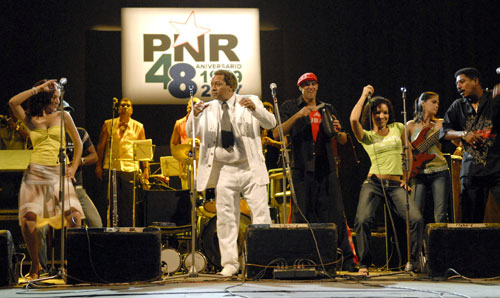12.20.3 NG The Band

NG La Banda, a Cuban musical orchestra founded in 1988 by flautist José Luis Cortés (El Tosco). Its name means New Generation. The group’s debut took place at the Café Cantante of the Bertolt Brecht Theater in Havana, on April 4, 1988.
Its director, a highly experienced artist who had been a member of two of the most prominent groups in Cuban music, Los Van Van and Irakere, set his goal of merging the simplicity and appeal that characterize the music performed by Los Van Van with the complexity and elaboration of Irakere’s music. In other words, a music that blends jazz with purely Cuban rhythms, but with a more modern approach to dance music.
NG was made up entirely of musicians of high interpretative quality who had been part of important Cuban groups, such as La Ritmo Oriental; Irakere and Pachito Alonso. Hence, its brass section was known as the brass of terror. Among them we can mention: José Luis Cortés (director, flautist and vocals); Germán Velazco and Carlos Averhoff (saxophones); Elpidio Chapottin, José Miguel Crego (El Greco) and Juan Munguía (trumpets); Tony Calá and Issac Delgado (singers); Juan Nogueras (Wikly) (tumbadora); Feliciano Arango (bass); Giraldo Piloto (drums); Rodolfo Argudìn (Peruchín) (piano); Miguel Ángel D’Armas (keyboard) and Bárbaro Argudín (bongo).
NG La Banda established a timbre, a style, a way of making Cuban dance music. The orchestra’s music has always been distinguished by its distinctive rhythmic richness, with extraordinarily precise arrangements, complex harmonies, and blends of funk, blocks, percussion sections, scintillating melodic ideas, and Afro-Cuban dance music. This latter characteristic is evident in songs such as Los Sitios Entero and Santa Palabra.
The Cuban musical genre we now know as Timba was conceived by NG La Banda, a group considered by many to be the inventor and pioneer of this musical style. It wasn’t Son, Songo, or Rumba, nor Rock, Jazz, or Funk, but it had a lot of all of these styles within it. It was one of the greatest influences on the great Timba groups that followed in its footsteps. Most of the 1990s bands came directly from its foundations.
The band’s first album was titled “No puede tapar el sol” (1988). It featured some of the band’s earliest hits, such as “La expresiva” and “Los sitios entero.” Their second album, “Salseando” (1990), was released with Malena Burke and features songs from a variety of genres, including Guajira, Guaguancó, Cha-cha-chá, and Son. It featured songs like “Me voy pa’l pueblo” (Me voy pa’l pueblo) and “Bruca Maniguá.”
In 1993, NG recorded several albums, including “On the Street”; “From NG to Curaçao”; “Panoramic Cabaret”; and “NG Arrived, Camará.”
Several songs have been musical hits both nationally and internationally. With these songs, they have contributed to a major revolution in Cuban popular music, including Santa Palabra, La Expresiva, Lelolei, La Aprendora, La Bruja, Echale Limón, and La Cachimba, among others, and have become one of Cuba’s best bands.
NG is considered a top-notch orchestra by many critics. Among them, Ben Tavera King of the San Antonio Express-News, USA, said: “It’s probably the best salsa orchestra in the Western Hemisphere.”
Their productions are varied, ranging from a live album, “Live from the Patio of My House,” to a jazzy mixtape like “Our Man in Havana.” They also released a 1997 compilation, “Best of NG La Banda,” which includes some significant and popular songs.
The orchestra currently boasts young Cuban musical talents among its members. It features four female voices, maintaining the vocal timbre that has characterized it since its founding with Tony Calá.
This group not only performs popular music to get their fans dancing, but also does excellent work with instrumental music and jazz, thanks to the virtuosity displayed by their musicians.
NG La Banda performs in various Havana clubs, filling the night with performances of great rhythm and Cuban flavor, ensuring the audience enjoys an unforgettable evening.
In 2010, NG released a new album called Mis 22 años (My 22 Years), produced by EGREM (1008 3rd Street between 10th and 12th Streets, Miramar, Playa, Havana). With this album, the group made up for a gap of several years without showing its fans a record of its own. This album brought together important figures of Cuban dance music from the country, including Juan Formell, Chucho Valdés, Adalberto Álvarez, Rafaelito Lay, Paulito FG, Lazarito Valdés, Manolito Simonet, Pachito Alonso, David Calzado, and César (Pupi) Pedroso, who were accompanied by members of their groups. It also features soloists such as Haila María Mompié, Vania Borges, and Osdalgia, among others.
Each and every one of NG La Banda’s anniversaries has been and continues to be celebrated at La Tropical (41st and 46th Avenues, Playa, Havana). A grand concert is usually organized for this celebration, featuring the best salsa orchestras in Cuba.
NG has brought Cuban music to countless stages around the world and has performed in the best concert venues in Europe such as the Frankfurt Salsa Festival, Holland Salsa, The Nice Jazz Festival, The Paris Caribbean Festival, Salsa Festival in Madrid, Festival de Soneros de Santa Coloma, Salsa Festival of Puerto Rico, Festival de Soneros de Santa Cruz de Tenerife, to name a few.
Discography: You can’t cover the sun (1988), Salseando (1990), In the street (1993), From NG to Curaçao (1993), Panoramic Cabaret (1993), NG arrived, camera (1993), NG La Banda. The one who rules (1994), The witch (1995), Give it a lemon (1995), Live from the patio of my house (1995), Our man in Havana (1995), “Best of NG La Banda” (1997), Son Cubano (2000), Bailemos. NG la Banda performs songs by Almeida (2006) and My 22 years (2010).








